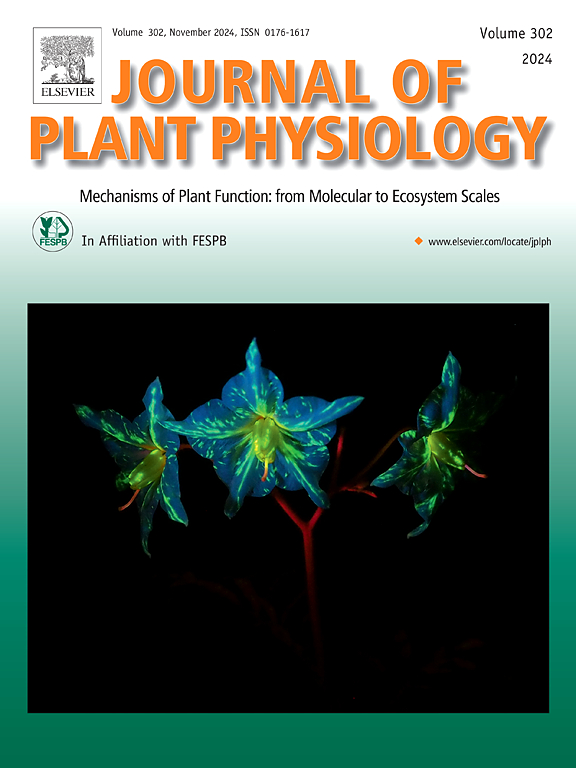Overexpression of pumpkin (Cucurbita pepo L.) CpVQ20 increases resistance to powdery mildew via antioxidant defense and callose accumulation
IF 4.1
3区 生物学
Q1 PLANT SCIENCES
引用次数: 0
Abstract
Cucurbita pepo powdery mildew (PM) is mainly caused by Podosphaera xanthii. It can readily induce wilting of pumpkin (Cucurbita pepo L.) branches and leaves, and may even lead to stunted growth and fruit deformities, significantly impacting both the quality and yield of Cucurbita pepo. VQ (Valine-glutamine) proteins play a crucial role in enhancing plant resistance to various abiotic and biotic stresses. In this study, qPCR analysis showed that after powdery mildew infection, the relative expression of CpVQ20 increased in disease-resistant material F2 and decreased in susceptible material M3. Cucurbita pepo CpVQ20 was localized in the nucleus. We observed a reduced incidence of powdery mildew in CpVQ20-overexpression (OE) plants compared to the wild-type (WT). Furthermore, powdery mildew mycelium grew slower and accumulated less. The activities of antioxidases were enhanced, while the levels of reactive oxygen species (ROS) and malondialdehyde (MDA) were diminished. Overexpression of CpVQ20 increased callose content in Cucurbita pepo. The expression levels of callose synthase gene and defense-associated genes were elevated. This study concludes that CpVQ20 positively regulates resistance to powdery mildew. This pioneering research establishes a robust foundation for future breakthroughs in gene improvement and genetic breeding.
南瓜(Cucurbita pepo L.)过表达CpVQ20通过抗氧化防御和胼胝质积累增加对白粉病的抵抗力
葫芦白粉病(PM)是一种主要由黄氏Podosphaera xanthii引起的病害。它很容易引起南瓜枝叶萎蔫,甚至可能导致生长发育迟缓和果实畸形,严重影响南瓜的品质和产量。谷氨酰胺(Valine-glutamine)蛋白在增强植物对各种非生物和生物胁迫的抗性中起着至关重要的作用。本研究通过qPCR分析发现,白粉病感染后,CpVQ20在抗病材料F2中相对表达量升高,在感病材料M3中相对表达量降低。瓜类CpVQ20定位于细胞核。我们观察到,与野生型(WT)相比,cpvq20过表达(OE)植株的白粉病发病率降低。此外,白粉病菌丝生长缓慢,积累较少。抗氧化酶活性增强,活性氧(ROS)和丙二醛(MDA)水平降低。过表达CpVQ20可提高葫芦的胼胝质含量。胼胝质合成酶基因和防御相关基因的表达水平升高。本研究认为CpVQ20正调控白粉病抗性。这项开创性的研究为基因改良和遗传育种的未来突破奠定了坚实的基础。
本文章由计算机程序翻译,如有差异,请以英文原文为准。
求助全文
约1分钟内获得全文
求助全文
来源期刊

Journal of plant physiology
生物-植物科学
CiteScore
7.20
自引率
4.70%
发文量
196
审稿时长
32 days
期刊介绍:
The Journal of Plant Physiology is a broad-spectrum journal that welcomes high-quality submissions in all major areas of plant physiology, including plant biochemistry, functional biotechnology, computational and synthetic plant biology, growth and development, photosynthesis and respiration, transport and translocation, plant-microbe interactions, biotic and abiotic stress. Studies are welcome at all levels of integration ranging from molecules and cells to organisms and their environments and are expected to use state-of-the-art methodologies. Pure gene expression studies are not within the focus of our journal. To be considered for publication, papers must significantly contribute to the mechanistic understanding of physiological processes, and not be merely descriptive, or confirmatory of previous results. We encourage the submission of papers that explore the physiology of non-model as well as accepted model species and those that bridge basic and applied research. For instance, studies on agricultural plants that show new physiological mechanisms to improve agricultural efficiency are welcome. Studies performed under uncontrolled situations (e.g. field conditions) not providing mechanistic insight will not be considered for publication.
The Journal of Plant Physiology publishes several types of articles: Original Research Articles, Reviews, Perspectives Articles, and Short Communications. Reviews and Perspectives will be solicited by the Editors; unsolicited reviews are also welcome but only from authors with a strong track record in the field of the review. Original research papers comprise the majority of published contributions.
 求助内容:
求助内容: 应助结果提醒方式:
应助结果提醒方式:


